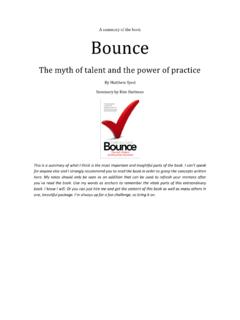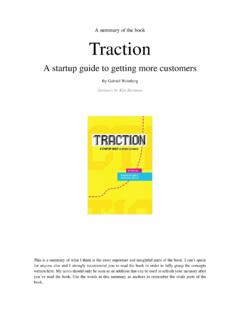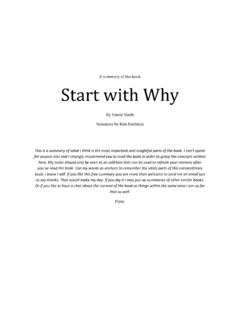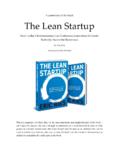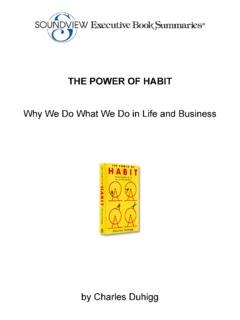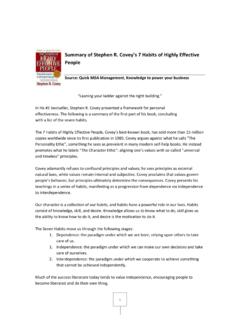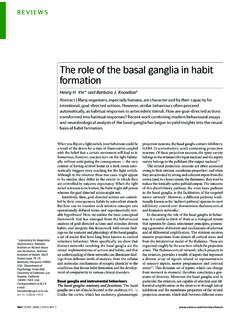Transcription of The Power of Habit Summary - Kim Hartman
1 A Summary of the book The Power of Habit Why we do what we do and how to change By Charles Duhigg Summary by Kim Hartman This is a Summary of what I think is the most important and insightful parts of the book. I can t speak for anyone else and I strongly recommend you to read the book in order to fully grasp the concepts written here. My notes should only be seen as an addition that can be used to refresh your memory after you ve read the book. Use the words in this Summary as anchors to remember the vitals parts of the book. More book summaries at Contact me at Contents Description from amazon.
2 2 Prologue .. 3 Part one The habits of individuals .. 4 Chapter 1: The Habit loop how habits work .. 4 Chapter 2: The craving brain how to create new habits .. 5 Chapter 3: The golden rule of Habit change why transformation occurs .. 6 Part two The habits of successful organizations .. 8 Chapter 4: Keystone habits which habits matter most .. 8 Chapter 5: The Habit of success when willpower becomes automatic.. 9 Chapter 6: The Power of crisis creating habits through accident and design .. 10 Chapter 7: When companies predict and manipulate habits .. 11 Part three The habits of societies.
3 12 Chapter 8: How movements happen .. 12 Chapter 9: The neurology of free will are we responsible for our habits ? .. 14 Appendix .. 15 Previous book summaries .. 16 The End .. 17 More book summaries at Contact me at Description from amazon In The Power of Habit , award-winning New York Times business reporter Charles Duhigg takes us to the thrilling edge of scientific discoveries that explain why habits exist and how they can be changed. With penetrating intelligence and an ability to distill vast amounts of information into engrossing narratives, Duhigg brings to life a whole new understanding of human nature and its potential for transformation.
4 Along the way we learn why some people and companies struggle to change, despite years of trying, while others seem to remake themselves overnight. We visit laboratories where neuroscientists explore how habits work and where, exactly, they reside in our brains. We discover how the right habits were crucial to the success of Olympic swimmer Michael Phelps, Starbucks CEO Howard Schultz, and civil-rights hero Martin Luther King, Jr. We go inside Procter & Gamble, Target superstores, Rick Warren's Saddleback Church, NFL locker rooms, and the nation's largest hospitals and see how implementing so-called keystone habits can earn billions and mean the difference between failure and success, life and death.
5 At its core, The Power of Habit contains an exhilarating argument: The key to exercising regularly, losing weight, raising exceptional children, becoming more productive, building revolutionary companies and social movements, and achieving success is understanding how habits work. habits aren't destiny. As Charles Duhigg shows, by harnessing this new science, we can transform our businesses, our communities, and our lives. More book summaries at Contact me at Prologue Keystone Habit : focus on one pattern a keystone Habit - and reprogram the other routines in your life as well.
6 40% of the actions people perform each day aren t actual decisions but habits . The riot in Iraq example: Violence was usually preceded by a crowd of Iraqis gathering in a plaza or an open space, and over the course of several hours, growing in size. Food vendors would show up, as well as spectators. Then someone would throw a rock and hell broke loose. The police prohibited the food vendors from entering the plaza and people gathered as usual. The crowd grew in size, but at dusk people started to get hungry and there were no kebab to be found nearby. The chanters became dispirited, and at 8pm everyone was gone.
7 More book summaries at Contact me at Part one The habits of individuals Chapter 1: The Habit loop how habits work habits emerge because the brain is constantly looking for ways to save effort. The Habit loop: The process with our brain is a three-step loop. First, there is a cue, a trigger that tells your brain to go into automatic mode and which Habit to use. Then there is the routine, which can be physical or mental or emotional. Finally, there is a reward, which helps your brain figure out if this particular loop is worth remembering for the future.
8 Cue routine reward Over time, this loop becomes more and more automatic. The cue and reward become intertwined until a powerful sense of anticipation and craving emerges. Eventually, a Habit is born. When a Habit emerges, the brain stops fully participating in decision making. It stops working so hard, or diverts focus to other tasks. So unless you deliberately fight a Habit unless you find new routines the pattern will unfold automatically. habits never really disappear. They are encoded into the structures of our brain. If we learn to create new neurological routines that overpower those behaviors if we take control of the Habit loop we can force those bad tendencies into the background.
9 And once someone creates a new pattern, studies have demonstrated, going for a jog or ignoring the doughnuts becomes as automatic as any other Habit . habits , as much as memory and reason, are at the root of how we behave. We might not remember the experiences that create our habits , but once they are lodged within our brains the influence how we act often without our realization. Example: McDonalds and kids. When the kids are starving and you are driving home after a long day it makes sense to stop by McDonalds it s inexpensive and taste good. One meal of processed food can t be that bad, right?
10 But habits emerge without our permission. Studies indicate that families usually don t intend to eat fast food on a regular basis. What happens is that a once in a month pattern slowly becomes once in a week, and then twice a week. As the cues and rewards creates a Habit until the kids are consuming an unhealthy amount of hamburgers and fries. There are a number of cues and rewards that most customers never knew were influencing their behavior every McDonalds looks the same, the employees says the same things, so everything is a consistent cue to trigger eating routines. More book summaries at Contact me at The fries are designed to begin disintegrating the moment they hit your tongue, in order to deliver a hit of salt and grease as fast as possible, causing your pleasure centers to light up and your brain to lock in the pattern.

